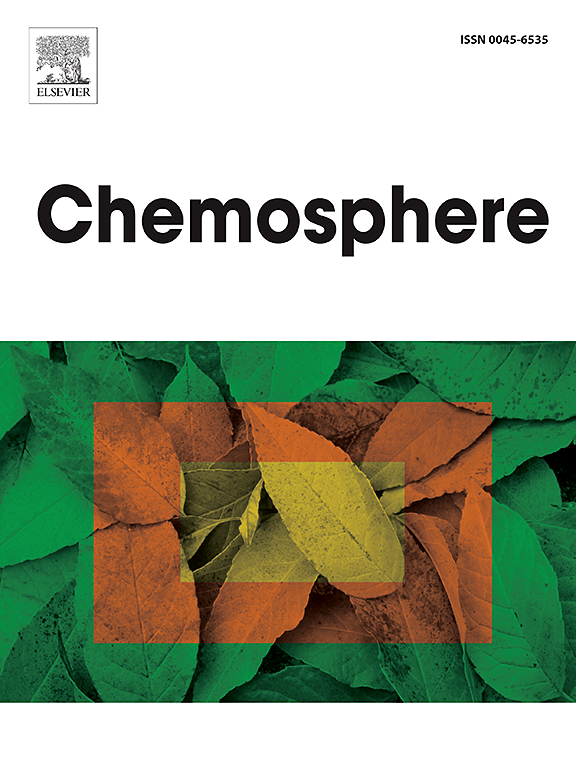Assessing neurological and cardiovascular effects caused by pharmaceuticals in river water: Insights from Daphnia magna and Danio rerio embryos
IF 8.1
2区 环境科学与生态学
Q1 ENVIRONMENTAL SCIENCES
引用次数: 0
Abstract
Pharmaceutical residues in surface waters are an emerging environmental and public health issue, yet their biological impacts on aquatic life remain poorly understood. This study presents a cost-effective bioanalytical framework using Daphnia magna juveniles and zebrafish (Danio rerio) embryos to evaluate neurotoxic and cardiotoxic effects of pharmaceutical mixtures in rivers downstream of wastewater treatment plant (WWTP) effluents. Water samples from three rivers in north-eastern Spain (Besòs, Llobregat, and Onyar) were concentrated up to 5- and 20-fold using solid-phase extraction. Bioassays were conducted over 24 h for D. magna and five days for zebrafish embryos.
Eighty pharmaceutical compounds were quantified via HPLC-MS and linked with phenotypic endpoints including locomotion, feeding, heart rate, neurotransmitter profiles, and metabolomic alterations. Of the 28 concentrated extracts, four were acutely toxic to zebrafish embryos. Altered behavioral and cardiovascular responses were observed in 22.2 % (D. magna) and 35.1 % (D. rerio) of extracts, primarily at higher enrichment. Concentrations of 31 pharmaceuticals were statistically associated with observed effects. Neuroactive drugs such as topiramate, rasagiline, citalopram, and fluvoxamine showed strong correlations with altered neurotransmitter levels in zebrafish, consistent with their known mechanisms. Seven additional compounds with secondary neuroactive properties were linked to similar neurological disruptions. Seventeen pharmaceuticals were associated with disturbances in amino acid metabolism and urea cycle pathways, indicating broader metabolic dysregulation.
Overall, nearly 75 % of river extracts showed no observable effect, but several samples were acutely toxic or induced sublethal neurobehavioral and metabolic responses. These findings support the utility of D. magna and zebrafish (D. rerio) embryos as sensitive and complementary biosentinels for monitoring pharmaceutical pollution and highlight zebrafish as a relevant model for studying environmentally driven neurotoxicity with potential human health implications.

评估河水中药物对神经系统和心血管的影响:来自大水蚤和达尼奥胚胎的见解
地表水中的药物残留是一个新兴的环境和公共卫生问题,但它们对水生生物的生物学影响仍然知之甚少。本研究提出了一个具有成本效益的生物分析框架,使用大水蚤幼鱼和斑马鱼胚胎来评估废水处理厂(WWTP)废水下游河流中药物混合物的神经毒性和心脏毒性作用。来自西班牙东北部三条河流(Besòs, Llobregat和Onyar)的水样使用固相萃取浓缩至5倍和20倍。生物测定对大鼠进行24 h,对斑马鱼胚胎进行5 d。80种药物化合物通过HPLC-MS进行定量,并与表型终点相关联,包括运动、喂养、心率、神经递质谱和代谢组学改变。在28种浓缩提取物中,有4种对斑马鱼胚胎有急性毒性。在22.2% (D. magna)和35.1% (D. rerio)的提取物中观察到行为和心血管反应的改变,主要是在更高的浓度下。31种药物的浓度与观察到的效果有统计学相关性。神经活性药物,如托吡酯、雷沙吉兰、西酞普兰和氟伏沙明,与斑马鱼神经递质水平的改变有很强的相关性,这与它们已知的机制一致。另外7种具有次级神经活性的化合物与类似的神经紊乱有关。17种药物与氨基酸代谢和尿素循环途径的紊乱有关,表明更广泛的代谢失调。总体而言,近75%的河流提取物没有显示出可观察到的效果,但一些样品具有急性毒性或诱导亚致死的神经行为和代谢反应。这些发现支持了D. magna和斑马鱼(D. rerio)胚胎作为监测药物污染的敏感和互补的生物前哨的效用,并突出了斑马鱼作为研究环境驱动的神经毒性与潜在的人类健康影响的相关模型。
本文章由计算机程序翻译,如有差异,请以英文原文为准。
求助全文
约1分钟内获得全文
求助全文
来源期刊

Chemosphere
环境科学-环境科学
CiteScore
15.80
自引率
8.00%
发文量
4975
审稿时长
3.4 months
期刊介绍:
Chemosphere, being an international multidisciplinary journal, is dedicated to publishing original communications and review articles on chemicals in the environment. The scope covers a wide range of topics, including the identification, quantification, behavior, fate, toxicology, treatment, and remediation of chemicals in the bio-, hydro-, litho-, and atmosphere, ensuring the broad dissemination of research in this field.
 求助内容:
求助内容: 应助结果提醒方式:
应助结果提醒方式:


